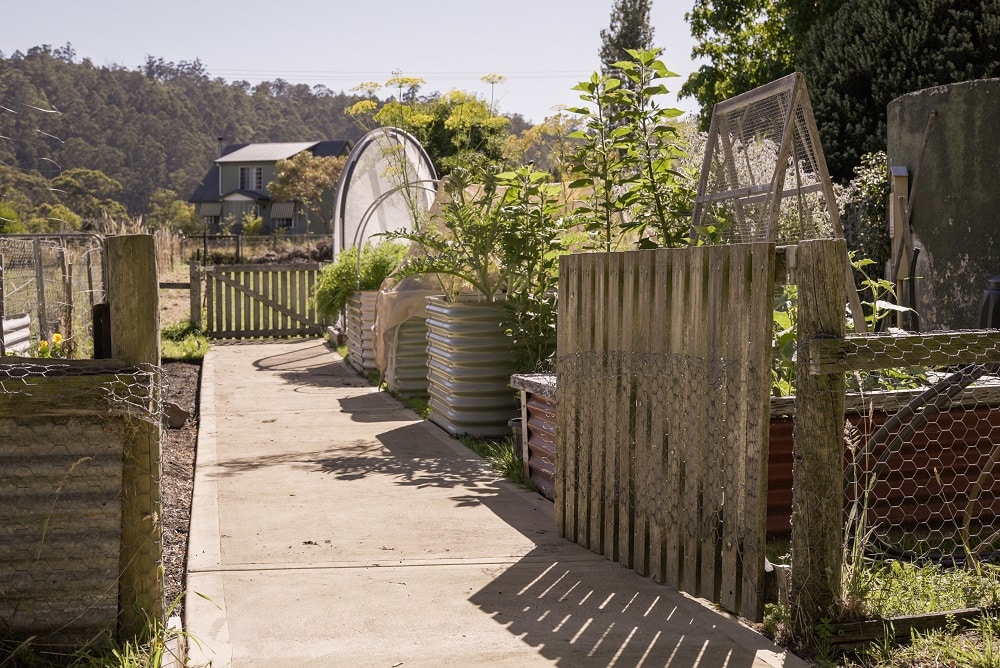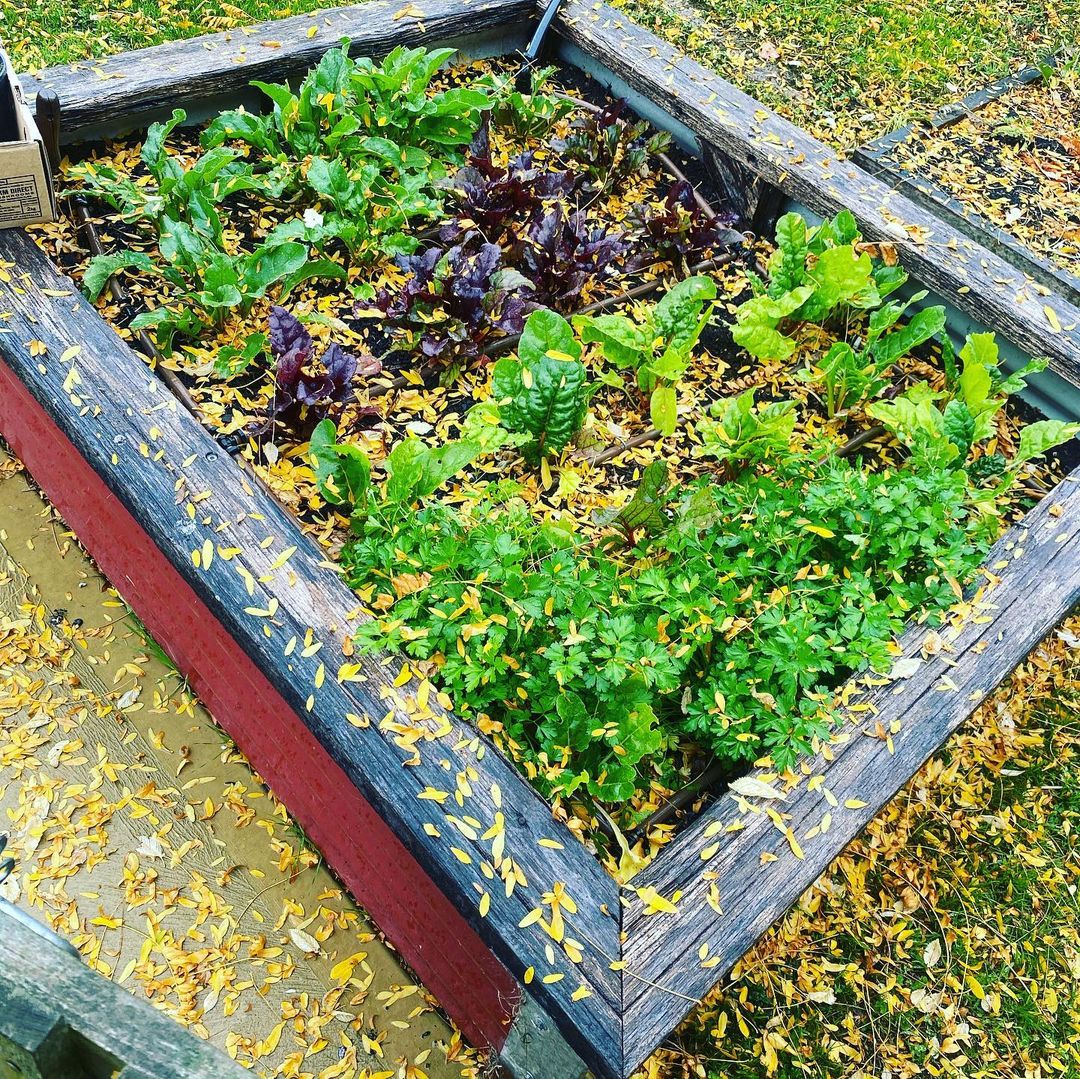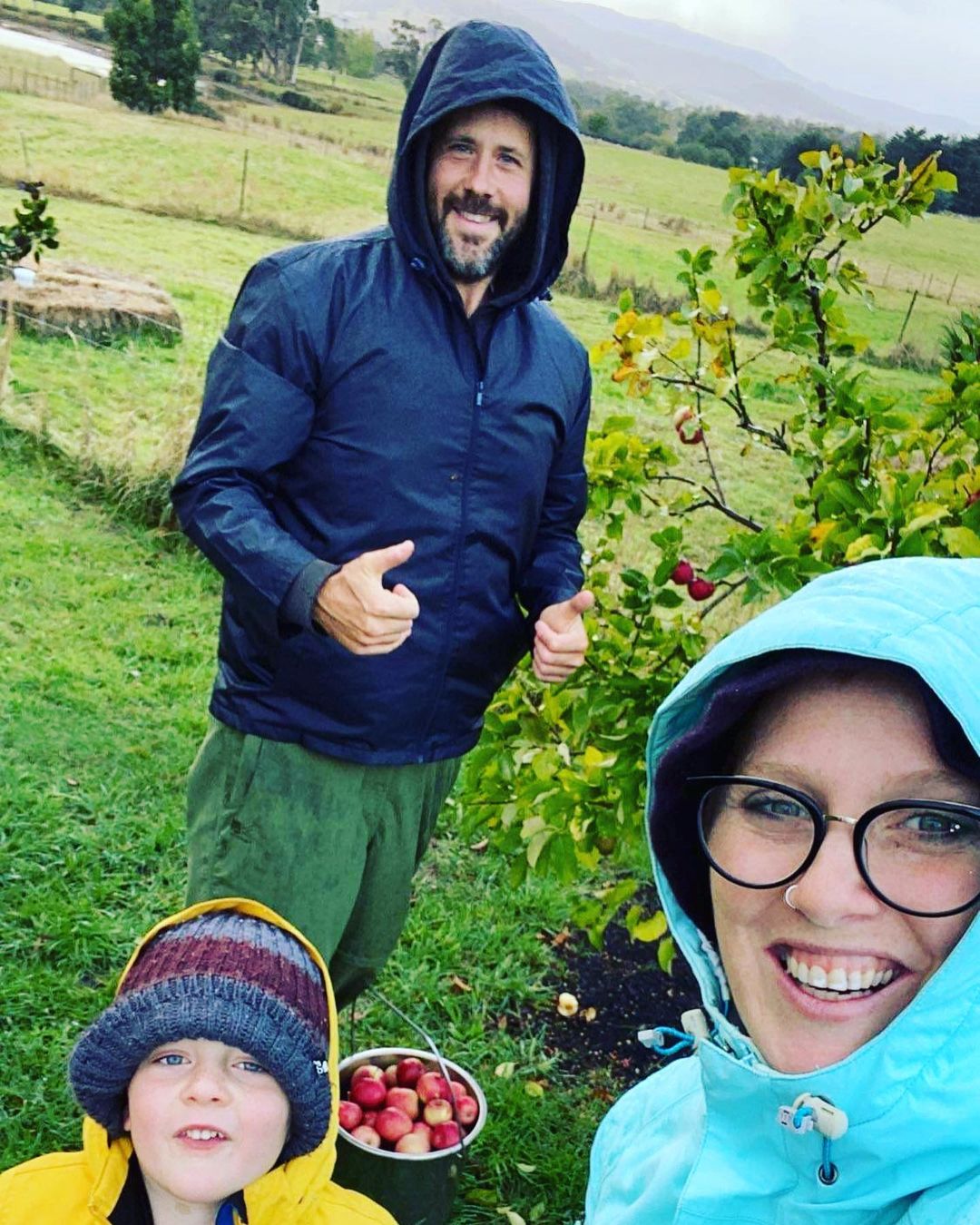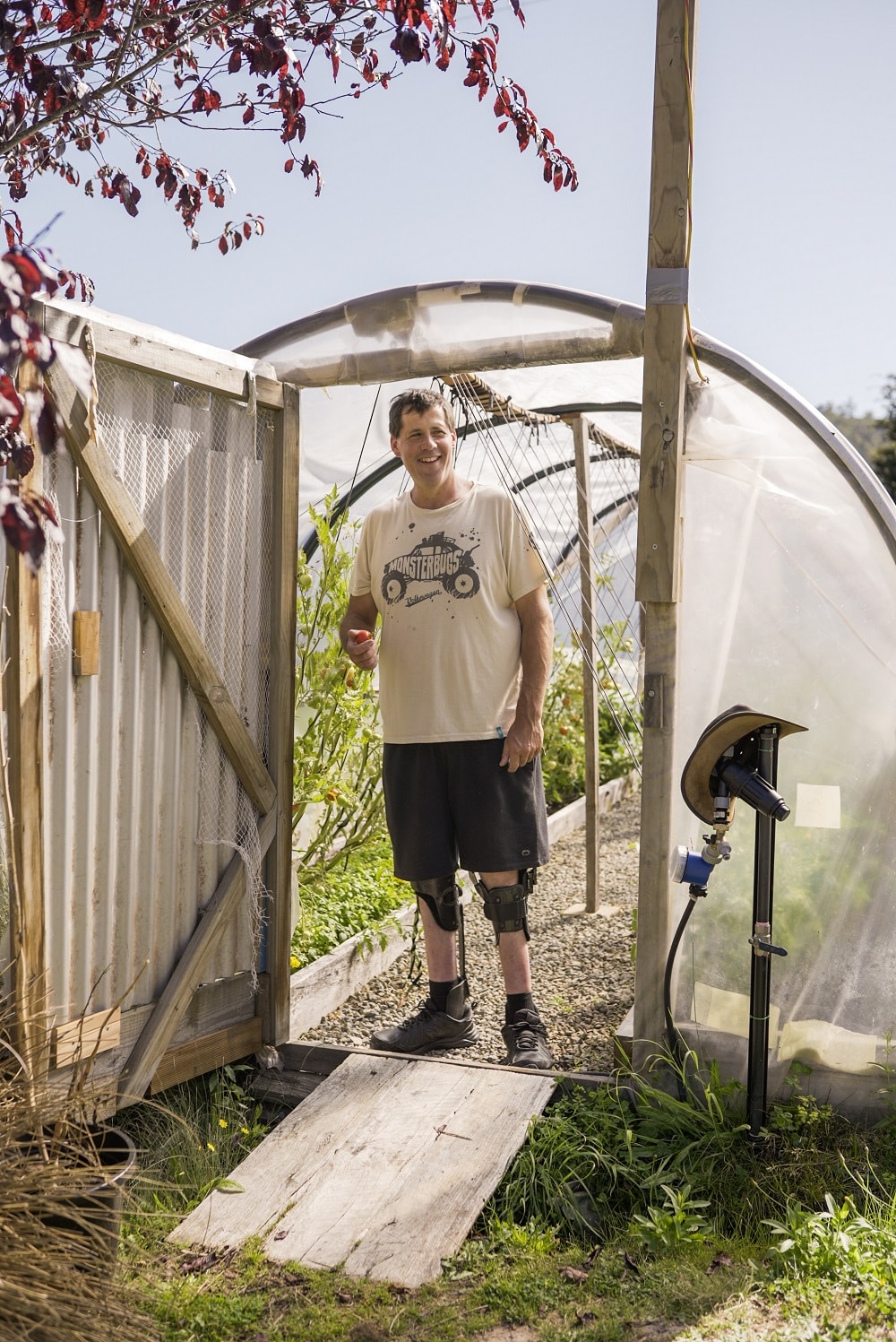

Grant Bailey was just 22 when a serious workplace accident in 2008 dramatically changed his life. His spinal cord was so badly injured that Grant permanently lost the use of his left leg.
In the 12 long months of recovery and rehabilitation that followed, Grant reevaluated almost every part of his life. Diagnosed with ‘incomplete paraplegia’, he was determined to make changes – including starting to grow even just a little of his own food.
And so he did – all through the next decade. As he learned wheelchair basketball in Sydney. After he moved to Ngunnawal Country (Canberra) to train as a Paralympian rower. And when, in 2014, he became the first person in the Asia Pacific to be fitted with an innovative C-Brace robotronic leg.
In 2018, Grant and his family moved to a three-acre property on melukerdee country in talune (Cygnet, Tasmania) – right near our Milkwood HQ!
Here he set up an edible garden that we reckon you’ll want to know about…
Because, with a few relatively simple design tweaks, Grant has ensured his garden is accessible for people of all abilities. He can tend his veggies easily while standing (wearing his C-Brace) or from his wheelchair, on the days he needs to use one.
So let’s sit down with Grant (who also happens to be a student of our Milkwood Permaculture Living course) for a chat about his productive space, as well as some tips on how you can set up an all-abilities veggie garden at your place, too…

Grant! Tell us a bit about your garden and property here in talune (Cygnet)…
My wife Lauren and I both grew up in the suburbs on the mainland (of Australia), and our family and friends thought we were mad when we decided to be a bit crazy and zip down Tasmania way to seek a different type of lifestyle. I’m glad we proved them wrong.
We bought our three-acre property knowing nothing about fruit trees or how to manage the land. We’d grown a lot of veggies in all the places we lived, out in the garden and in raised beds, but not on this scale.
The previous owner was a market gardener and sold seedlings, so the property is pretty well set up. We have 40 fruit trees across the farm too. It’s a beautiful place.
After we moved in, I ended up doing a proper dedicated garden area with seven raised beds and wide pathways for ease of access, which makes it far easier to bring in a wheelchair, that kind of thing.
Plus we have a polytunnel, which is about extending our growing time. In mid-autumn, we’ll still have a few tomatoes hanging on, even when the weather gets down to four degrees.
We always grow our staples like lettuce, tomatoes, chillies, basil, silverbeet, garlic, all the brassicas, artichoke, asparagus, zucchinis, cucumbers, all types of beans, onions and beetroot. I guess we grow whatever is in session, plus something new each season that we haven’t grown before.

You designed your all-abilities veggie garden with the knowledge that your mobility may decrease in the future?
Yes, it was based around my mobility now, but also the potential loss in the future – because as you get older, your body gets weaker. I’m pretty lucky, because the technology of the C-Brace will probably help me to walk as long as possible.
I have a spinal cord injury and I’ve lost function mainly in my left leg. I was able to convince my insurance company that this C-Brace device, manufactured in Germany, would help a lot – so in 2014, I was the first person in the Asia Pacific to get one.
It changed everything. It works like a robotronic leg. It has in-built sensor technology and uses microprocessors to work out what’s going on, so the orthosis controls my walking movements as I take each step.
The components sit on the outside of my leg – the first version was very chunky, about the size of the average person’s shoe, and it sat just above my knee. I wore that for about five years. Then they developed a new one that’s more water-resistant, and it’s about half the weight and a quarter of the size. I can fit in a pair of pants quite nicely now, which is great.
But even now, if I get really sick, it affects my balance. And then it’s not particularly safe for me to be walking around.
So I do have a wheelchair. It’s pretty dusty at the moment as I haven’t had to use it for awhile, but it’s there for those times when I’m dizzy or nauseous and can’t walk safely.

The width of your paths was a key element to ensuring you can access your garden from a wheelchair if you need to?
All the pathways are about a metre wide. This means you can accommodate a wheelchair easily. Or, if you’re walking, you can have someone next to you. I walk a bit like a penguin, so it’s good to have that extra space.
In terms of the materials, the carbon footprint of concrete is pretty massive, but maintaining dirt or gravel is a lot of effort. I want to spend time growing food for my family, so we decided the best choice was concrete with a colourant in it, so it looks like it’s part of the natural environment.
We’re in a heavy frost zone so slippery ice can form on pathways if they don’t have a textured finish. We made the concrete rough-textured to avoid this, and to give a bit more traction. A non-slip surface is crucial.

You’ve retrofitted a polytunnel to be more accessible too?
Yeah, one winter we had a massive crazy storm that blew a trampoline into our 12-metre long polytunnel and took the whole thing out.
So I rebuilt it, reduced it by half, repurposed all the materials and converted it so it’s easier to get in with my wheelbarrow. My wheelchair is roughly the same width as the wheelbarrow, so that worked well – I just made the paths a little wider to allow for turning and such things.
I then made two long garden beds on both sides, about 900mm by 6m long, and then a big open area about 950mm wide, so I can turn around with the wheelchair. That was pretty important to have too.
I also made a ramp on one side so I could easily roll in with the wheelbarrow or my wheelchair – you open the door and wheel right in. I dug the main support into the ground and covered it with soil so it’s completely level.
Having a level entry to places is really important – a small step or lip can be a really annoying barrier for accessibility.

What about the height of your raised beds – is there a specific height that works best for folks with mobility challenges?
Outside of the polytunnel, we have seven raised garden beds. Most of them are the standard 900mm high – they’re powder-coated corrugated galvanised steel beds that we picked up secondhand.
Then we’ve got another raised bed that is 600mm off the ground, which is designed to be a sitting bed, for me to access from my wheelchair. We also have a couple of garden beds that are only 300mm high.
And things we grow direct in the ground, like broad beans and garlic, we’ve put right on the edge of the path so access is really easy.
One of the things we had to work around was filling these raised garden beds without spending a huge amount of money.
So we practiced the hugelkultur method – putting rotting tree limbs on the bottom, followed by food scraps and manure to really get the microorganisms and fungi going crazy, and then 400mm of soil on top of that.
It’s like a natural forest system – the water in the wood as it’s rotting down acts like a bit of a sponge, so it helps to retain moisture. And as the wood breaks down very slowly, the soil layer goes down so you can add new material to the bed as you’re planting new veggies – we add compost and chicken manure. The veggies just love it.

Why is gardening so important to you?
After my accident and being in hospital, I had a massive life change. I had that 12 months to reevaluate my life. Most people don’t get that opportunity because they’re so busy with everything. I needed to do something different and I decided I wanted to grow some food.
Now we produce a lot of the food our family of four eats. In spring and summer it’s probably about 80%, although in winter it’s a different story.
Being in the garden is so therapeutic for me. I feel that being connected to the land and the food we eat not only brings me so much joy, but also supports my mental health in a wonderful way.
Being able to nurture and be connected to our food systems and ecosystems brings me back to a place of clarity and calm. I think everyone should do a bit of gardening, if they can.

Huge thanks to Grant for sharing his story and tips. If you’d like to follow the journey of Grant and his wife Lauren, you can subscribe to their YouTube channel or follow Misty Mountain Homestead on Instagram.
Resources
Articles & online resources
- 5 ways to make a wheelchair-accessible garden – a useful list from the Assistive Technology Blog.
- Making gardens accessible – an illustrated PDF guide by the Sydney Royal Botanic Gardens, Community Greening program and Prince of Wales Hospital.
- Accessible Gardening Techniques – things to consider, by HGTV.
- Incorporating Disability Access and Therapeutic Spaces in Permaculture Design by the Permaculture Research Institute
- Accessing permaculture for people with chronic illness and/or disability by the Permaculture Women Magazine
- These Facebook groups – All Abilities Permaculture Australia and Permaculture, Chronic Illness, Neurodiversity and Disability
- Eco-Ableism: What It Is, Why It Matters and How It Affects Disabled People
Videos
- The Vegepod – wheelchair/disability-friendly gardening – by It’s a Wheely Good Life in Wollongong, Australia.
- From the Ground Up – Tools for disabled gardeners
- Permaculture and Disability
Books
- Accessible Gardening for People with Physical Disabilities by Janeen R. Adil.
- The Enabling Garden: Creating Barrier-Free Gardens by Gene Rothert
- Accessible Gardening by Joann Woy
- The Able Gardener by Kathleen Yeomans
About the author: Koren Helbig is a storyteller, urban permaculturalist, Marketing Manager here at Milkwood, and keeper of The Local Yum, an Adelaide (Kaurna land) city honesty stall full of homegrown produce.
We acknowledge that permaculture owes the roots of its theory and practice to traditional and Indigenous knowledges, from all over the world. We all stand on the shoulders of many ancestors – as we learn, and re-learn, these skills and concepts. We pay our deepest respects and give our heartfelt thanks to these knowledge-keepers, both past and present.













I’m so thankful for this article. I love the idea of gardening and using more permaculture principles in our yard but living in chronic pain with multiple sclerosis I just don’t have the motivation. This article made me realise that it’s possible.
Can’t wait to see what you get up to, Clare 🙂
You could make the perfect garden based around you and your lifestyle